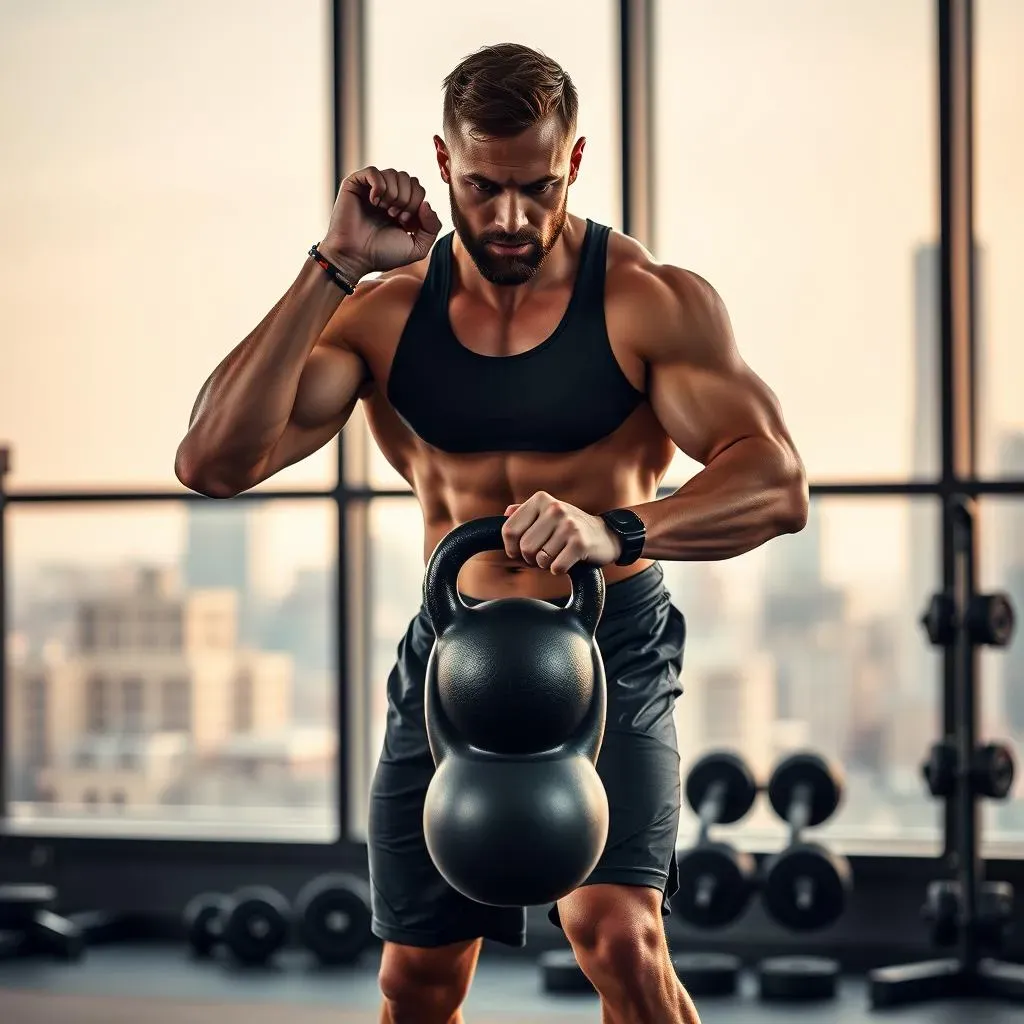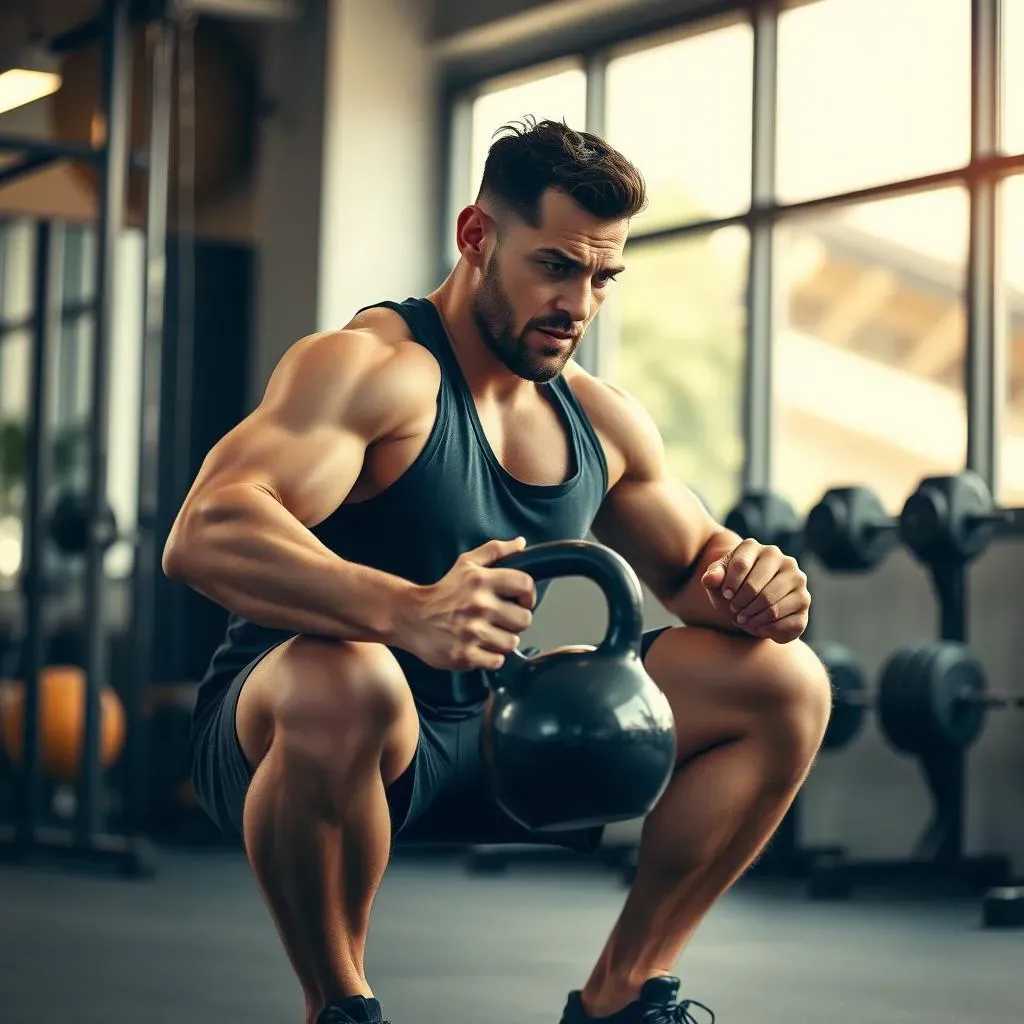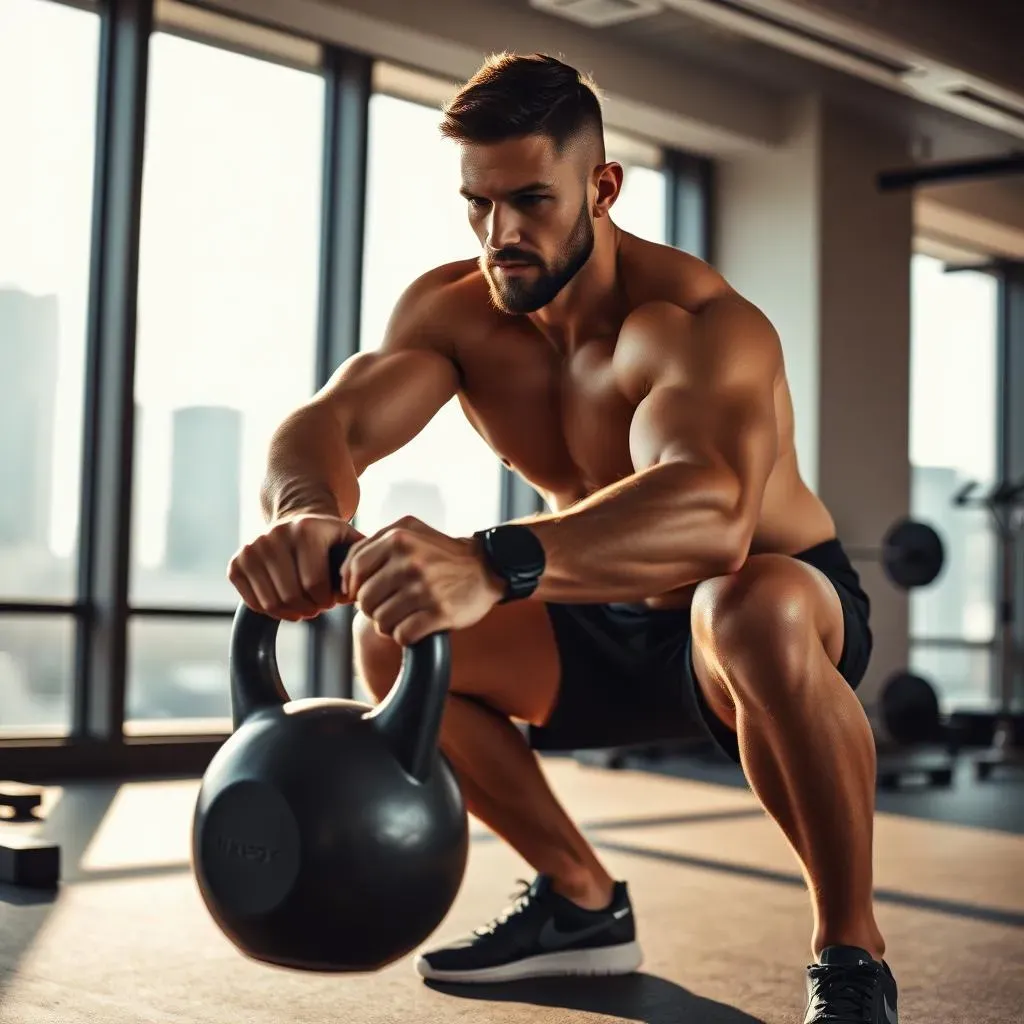Table of Contents
Gentlemen, are you ready to unlock the ultimate secret to stronger, more powerful legs? Forget boring leg days; we're talking about a revolutionary approach to lower-body training that will transform your physique and boost your overall health. This article dives into the world of "kettlebell leg workout men's health," revealing the incredible benefits of incorporating kettlebells into your fitness routine. We'll explore the science behind why kettlebell training is superior for building functional strength, power, and endurance in your legs. You'll discover the top kettlebell exercises specifically designed to target your quads, hamstrings, glutes, and calves, maximizing muscle growth and sculpting a lean, athletic lower body. But it's not just about aesthetics; we'll explore how a dedicated kettlebell leg workout improves your overall health, reducing your risk of injury, enhancing your balance and coordination, and boosting your metabolism. Get ready to build a stronger, more resilient you, one kettlebell swing at a time. This guide will walk you through mastering kettlebell techniques, creating effective workout routines, and tracking your progress to achieve your fitness goals. Prepare to experience the power and efficiency of kettlebell training – your legs (and your whole body!) will thank you.
Mastering Kettlebell Leg Workouts for Men's Health

Mastering Kettlebell Leg Workouts for Men's Health
Understanding Kettlebell Fundamentals
Let's be honest, kettlebells aren't just fancy weights; they're tools that demand respect. Before you launch into complex leg routines, mastering the basics is crucial. Think of it like learning to walk before you run – a wobbly start leads to a painful finish. Proper form is paramount to avoid injuries and maximize results. Start with the basics: the kettlebell deadlift, the goblet squat, and the swing. These foundational movements will build your strength, coordination, and confidence, laying the groundwork for more advanced techniques.
Focus on controlled movements, maintaining a neutral spine, and engaging your core throughout each exercise. Don't rush; quality over quantity is key, especially when you're first starting out. Start with lighter weights and gradually increase the weight as you get stronger. Remember, your body will thank you for the careful approach.
Exercise | Focus | Tip |
|---|---|---|
Kettlebell Deadlift | Hinge at the hips, maintain straight back | Engage your glutes |
Goblet Squat | Chest up, knees out | Control the descent |
Kettlebell Swing | Hip hinge, explosive power | Maintain core engagement |
Progressive Overload: The Key to Leg Gains
Think of your legs as a garden; you need to consistently nurture them to see growth. Progressive overload is the secret ingredient – it's all about gradually increasing the challenge over time. This isn't about suddenly doubling your weight; it's about smart, incremental changes. Perhaps you start with three sets of ten reps, then next week, you add one more rep to each set. Or maybe you increase the weight slightly. Small, consistent improvements lead to significant long-term gains. You're not just building muscle; you're building resilience and mental fortitude.
Don't be afraid to experiment with different kettlebell exercises, focusing on variations that challenge you. Consider incorporating unilateral exercises (working one leg at a time) to improve balance and target muscle imbalances. Remember, listening to your body is crucial. Rest and recovery are equally as important as the workout itself.
- Increase weight gradually
- Add reps or sets
- Try different variations
- Listen to your body
Nutrition and Recovery: Fueling Your Leg Power
You can't build a strong house on a weak foundation. Similarly, your leg workouts are only as good as your recovery. This means providing your body with the right fuel and ample rest. Nutrition plays a vital role in muscle growth and repair. Focus on a balanced diet rich in protein, complex carbohydrates, and healthy fats. Think of protein as the building blocks for your muscles, carbohydrates as the fuel for your workouts, and healthy fats as essential for hormone production and overall health. Proper hydration is crucial too; water is essential for muscle function and recovery.
Adequate sleep is also non-negotiable. Aim for 7-9 hours of quality sleep each night to allow your body to repair and rebuild muscle tissue. Don't underestimate the power of rest days; they're essential for preventing overtraining and injury. Remember, consistency is key – both in your workouts and your recovery habits. Treat your body like a high-performance machine; it needs the right fuel and maintenance to run optimally.
Top Kettlebell Exercises for Men's Leg Strength and Power

Top Kettlebell Exercises for Men's Leg Strength and Power
Kettlebell Goblet Squats: The King of Leg Exercises
Let's start with a classic: the goblet squat. Hold a kettlebell vertically against your chest, close to your body. It's like holding a big, heavy goblet, hence the name! Now, squat down as if you're sitting in a chair, keeping your back straight and your chest up. The goblet squat is fantastic for building overall leg strength, particularly in your quads and glutes. It's a fundamental movement that everyone should master. The beauty of this exercise lies in its simplicity and effectiveness. You can easily adjust the weight to match your fitness level, making it perfect for beginners and seasoned lifters alike.
Focus on controlled movements, ensuring your knees track over your toes and your weight is evenly distributed. Don't bounce at the bottom of the squat; maintain a steady, controlled descent and ascent. As you get stronger, you can add variations, such as pause squats or jump squats, to further challenge your muscles and boost your power.
Reps | Sets | Rest (seconds) |
|---|---|---|
10-12 | 3 | 60 |
Kettlebell Romanian Deadlifts (RDLs): Hamstring Heaven
Next up, we tackle the Romanian deadlift (RDL). This exercise is a hamstring powerhouse. Hold a kettlebell in each hand, keeping your arms straight. Hinge at your hips, pushing your glutes back as if you're about to sit in a chair, while keeping a slight bend in your knees. Lower the kettlebells towards the ground, keeping your back straight and your core engaged. The key is to feel the stretch in your hamstrings. As you return to a standing position, squeeze your glutes to complete the rep. The RDL is crucial for building strong, powerful hamstrings, which are essential for overall athletic performance and injury prevention.
Proper form is key here, so start with lighter weights and focus on controlled movements. Avoid rounding your back, and concentrate on the feeling of the stretch in your hamstrings. As you progress, you can incorporate variations, such as single-leg RDLs, to further challenge your balance and strength. Remember, building strong hamstrings will improve your overall athleticism and decrease your risk of lower-back pain.
- Maintain a straight back
- Focus on controlled movements
- Squeeze your glutes at the top
- Start with lighter weights
Kettlebell Swings: Explosive Power and Core Engagement
Finally, let's unleash the power of the kettlebell swing. This is a dynamic, full-body exercise that will not only build leg strength but also improve your cardiovascular fitness and core stability. Hold a kettlebell between your legs, hinge at your hips, and swing the weight backward, high between your thighs. Drive your hips forward to explosively blast it up to eye level. Let the momentum carry the kettlebell, focusing on using your hips to generate power. The kettlebell swing is a fantastic way to build explosive power in your legs and improve your overall athleticism.
Remember to keep your core tight throughout the entire movement, and avoid using your arms to lift the weight. The power should come from your hips and legs. The kettlebell swing is a highly effective exercise that burns calories, builds muscle, and improves your cardiovascular health. It’s a great addition to any leg workout routine.
Creating Your Personalized Kettlebell Leg Workout for Men's Health

Creating Your Personalized Kettlebell Leg Workout for Men's Health
Designing Your Workout: Frequency, Intensity, and Volume
So, you've mastered the fundamentals and are ready to craft your own killer leg workout? Awesome! The first thing to consider is workout frequency. How often can you realistically commit to leg day? Most men benefit from training legs 2-3 times per week, allowing sufficient rest for muscle recovery. Next, think about intensity. This isn't just about how heavy you lift; it's about how hard you push yourself during each set. Aim for a challenging intensity where you're feeling the burn but maintaining good form. Finally, there's volume – the total amount of work you're doing. This is determined by the number of sets and reps you perform for each exercise. A good starting point is 3 sets of 8-12 reps for each exercise.
Remember, consistency is key. It's better to have a shorter, more focused workout that you can stick to consistently than a longer, more ambitious one that you'll eventually abandon. Start with a manageable routine and gradually increase the frequency, intensity, or volume as you get stronger. And always, always prioritize proper form over lifting heavier weights. Your body will thank you for it in the long run.
Factor | Beginner | Intermediate | Advanced |
|---|---|---|---|
Frequency | 2x/week | 2-3x/week | 3-4x/week |
Sets | 2-3 | 3-4 | 4-5 |
Reps | 8-12 | 10-15 | 12-20 |
Exercise Selection and Progression: Building Your Leg Arsenal
Now for the fun part: choosing your exercises! You've already learned some foundational movements, but there's a whole world of kettlebell exercises waiting to be explored. For a well-rounded leg workout, incorporate a mix of compound exercises (like squats and deadlifts) that work multiple muscle groups simultaneously, and isolation exercises (like single-leg work) that target specific muscles. Remember the exercises we covered earlier – goblet squats, RDLs, and kettlebell swings – these are great starting points. Once you're comfortable, consider adding variations like Bulgarian split squats, single-leg RDLs, and Turkish get-ups. These variations add a new level of challenge and help prevent muscle imbalances.
As you progress, you'll want to implement progressive overload – the gradual increase in the challenge to stimulate muscle growth. This could involve increasing the weight, reps, sets, or even the difficulty of the exercise. Keep a workout log to track your progress and ensure you're consistently challenging yourself. Don't be afraid to experiment and find exercises you enjoy; this will keep you motivated and engaged in your fitness journey.
- Goblet Squats
- Kettlebell Romanian Deadlifts (RDLs)
- Kettlebell Swings
- Bulgarian Split Squats
- Single-Leg RDLs
- Turkish Get-Ups
Listen to Your Body and Adjust Accordingly: The Importance of Recovery
Finally, remember that fitness is a marathon, not a sprint. It's crucial to listen to your body and adjust your workout plan accordingly. Don't push through pain; that's a recipe for injury. Rest and recovery are just as important as the workout itself. Allow your muscles adequate time to recover between workouts, and don't hesitate to take rest days when needed. Pay attention to how your body feels; if you're consistently feeling fatigued, sore, or experiencing pain, it's time to dial back the intensity or frequency of your workouts.
Remember, proper nutrition plays a crucial role in muscle recovery and growth. Focus on a diet rich in protein, complex carbohydrates, and healthy fats. Stay hydrated, and get enough sleep. By paying attention to your body's signals and making necessary adjustments, you'll not only prevent injuries but also optimize your results. Remember, consistency and smart training are the keys to long-term success. Don't be afraid to adjust your plan as you progress, and always prioritize proper form and recovery.